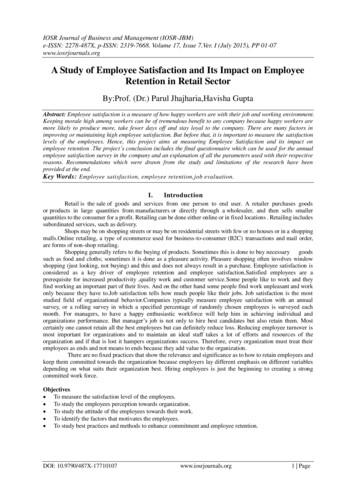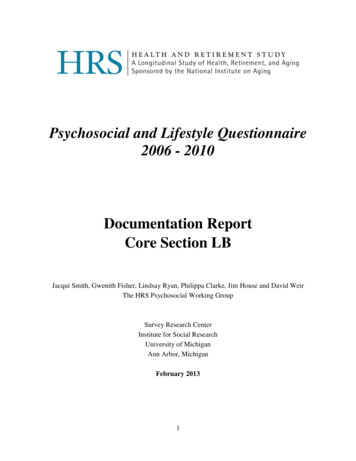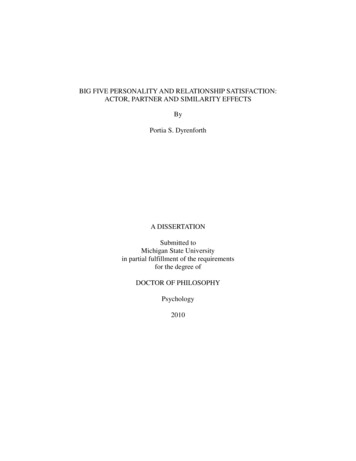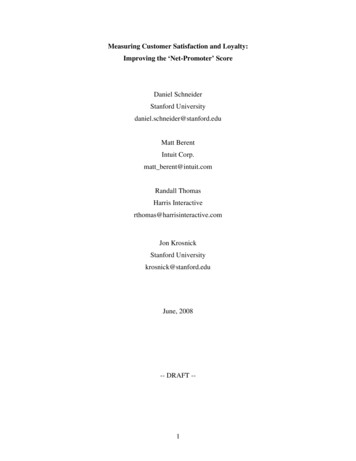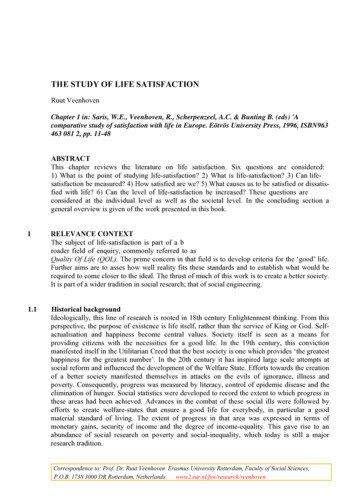
Transcription
THE STUDY OF LIFE SATISFACTIONRuut VeenhovenChapter 1 in: Saris, W.E., Veenhoven, R., Scherpenzeel, A.C. & Bunting B. (eds) 'Acomparative study of satisfaction with life in Europe. Eötvös University Press, 1996, ISBN963463 081 2, pp. 11-48ABSTRACTThis chapter reviews the literature on life satisfaction. Six questions are considered:1) What is the point of studying life-satisfaction? 2) What is life-satisfaction? 3) Can lifesatisfaction be measured? 4) How satisfied are we? 5) What causes us to be satisfied or dissatisfied with life? 6) Can the level of life-satisfaction be increased? These questions areconsidered at the individual level as well as the societal level. In the concluding section ageneral overview is given of the work presented in this book.1RELEVANCE CONTEXTThe subject of life-satisfaction is part of a broader field of enquiry, commonly referred to asQuality Of Life (QOL). The prime concern in that field is to develop criteria for the ‘good’ life.Further aims are to asses how well reality fits these standards and to establish what would berequired to come closer to the ideal. The thrust of much of this work is to create a better society.It is part of a wider tradition in social research; that of social engineering.1.1Historical backgroundIdeologically, this line of research is rooted in 18th century Enlightenment thinking. From thisperspective, the purpose of existence is life itself, rather than the service of King or God. Selfactualisation and happiness become central values. Society itself is seen as a means forproviding citizens with the necessities for a good life. In the 19th century, this convictionmanifested itself in the Utilitarian Creed that the best society is one which provides ‘the greatesthappiness for the greatest number’. In the 20th century it has inspired large scale attempts atsocial reform and influenced the development of the Welfare State. Efforts towards the creationof a better society manifested themselves in attacks on the evils of ignorance, illness andpoverty. Consequently, progress was measured by literacy, control of epidemic disease and theelimination of hunger. Social statistics were developed to record the extent to which progress inthese areas had been achieved. Advances in the combat of these social ills were followed byefforts to create welfare-states that ensure a good life for everybody, in particular a goodmaterial standard of living. The extent of progress in that area was expressed in terms ofmonetary gains, security of income and the degree of income-equality. This gave rise to anabundance of social research on poverty and social-inequality, which today is still a majorresearch tradition.Correspondence to: Prof. Dr. Ruut Veenhoven Erasmus University Rotterdam, Faculty of Social Sciences,P.O.B. 1738 3000 DR Rotterdam, Netherlands. www2.eur.nl/fsw/research/veenhoven
Ruut Veenhoven2The study of life satisfactionIn the 1960s, by which time most Western Nations had extensive Welfare-States, the new themeof ‘limits to economic growth’ appeared on the political agenda, and values came to shift to‘post-materialism’. This called for a broader conceptualisation of the good life and itsmeasurement. As a result, the term ‘quality of life’ was introduced. The initial use of theconcept was polemical, serving to denote that there is more to human existence than materialwelfare.1.2Social indicator movementDisenchantment with the traditional economic criteria of welfare led to the development of‘social’ indicators. And since economic indicators guide economic policy, it was argued thatsocial indicators were required to guide social policy. The search for suitable indicators of noneconomic welfare began in the early 1970's. Various pioneering studies were initiated at thattime (see below). International agencies organised expert conferences (OECD, UN). In manyWestern Nations social-indicator study centres emerged; either as semi-government foundations(USA, Netherlands), or as departments added to the bureau’s of statistics (Sweden), or as longterm research-programs at universities (Germany). In several countries periodical quality of lifesurveys were started; for example the ‘Level of Living Survey’ in Sweden, the ‘General SocialSurvey’ in the USA and (parts of) the bi-annual ‘Eurobarometer’ in the European Union.Results from such activities are regularly presented in Social-Indicator-Reports, such as thethree annual ‘Socio-Cultural Report’ in the Netherlands. These developments are frequentlyreferred to as the ‘Social Indicator Movement’. The economic recessions of 1975-76 and 198082 and the related development of mass unemployment soon diverted attention from noneconomic goals. Though policy interest and funding dwindled, the field matured scientifically.In the 1980's the fruits of the early studies started in the early 1970's began to be harvested.Several important books in this area were published, such as ‘The Quality of American Life’(Campbell et al., 1976), ‘Social Indicators of Well-being’ (Andrews and Withey 1976), ‘TheSocial Progress of Nations’ (Estes 1984), and ‘Lebensqualität in der Bundesrepublik’ (Glatzerand Zapf 1984).Today the field of social indicator research can be characterised as one of many well establishedsocial scientific specialisations. There is an international journal, called ‘Social IndicatorsResearch’, which publishes contributions from economists, sociologists and psychologists1.There is also an international newsletter, entitled ‘Social Indicator Network’ (SINET)2.Specialists from various countries meet regularly at conferences of the InternationalSociological Association (ISA), which has an active Working Group on Social Indicators(WG05)3. Recently a new study group has established: the international society for the study ofQuality of Life (ISSQOL)4.
Ruut Veenhoven1.31.43The study of life satisfactionConceptions of quality of lifeCurrently, the term 'quality of life' denotes two meanings: 1) the presence of conditions deemednecessary for a good life, and 2) the practice of good living as such. When used at the societallevel, only the former meaning applies. When we say that the quality of life of the people in acountry is poor, we mean that essential conditions are lacking, such as sufficient food, housingand health care. In other words: the country is not ‘liveable’ for its inhabitants. At the individuallevel, the term quality of life can take on both meanings. When we say that somebody doesn'thave a good life, we may mean that he/she lacks things deemed indispensable and/or that thisperson does not thrive. These conditions may coincide, but this is not necessarily the case. Aperson can be rich, powerful and popular, but still be troubled. On the other hand, someone whois poor, powerless and isolated, may nevertheless be thriving both mentally and physically. Irefer to these variants as respectively: ‘presumed’ quality of life and ‘apparent’ quality of life5.Use of life satisfactionLife-satisfaction is one of the indicators of ‘apparent’ quality of life. Together with indicators ofmental and physical health, it indicates how well people thrive. Data about life-satisfaction isused for several purposes.Measuring quality of lifeThe most elementary use of life-satisfaction data is to estimate apparent quality of life withina country or a specific social group. This is typically done to assess the extent of a socialproblem or issue and to recommend possible policy interventions. High satisfaction suggeststhat the quality of life, in the population concerned, is good. Though conditions may not beideal, it is apparently acceptable for most of the population. Low satisfaction marks seriousshortcomings of some kind. An example is the assessment of life-satisfaction among singlepeople. In all modern nations, single persons express less pleasure with life than marriedpersons, and the divorced and widowed frequently express the lowest levels of satisfaction withlife. This difference in life-satisfaction between those who are single and those with a partner isin fact greater than that expressed between rich and poor (Veenhoven, 1984:6/4). This iscommonly explained in terms of ‘deprivation’. Apparently, singles lack something essential inlife. A problem is that dissatisfaction with life means that something is wrong, but it does notindicate what. The discontent of the unmarried could be due to negative labelling, but it can alsobe attributed to loneliness and lack of social support.Monitoring social progressA related application of life-satisfaction data is the monitoring through time. If averagesatisfaction levels increase, this suggests that the quality of life in the country or social grouphas improved. When satisfaction declines, this indicates possible problems. An example ofmonitoring at the national level is Easterlin's (1974) analysis of the development of lifesatisfaction and economic growth in the post-war decades in the USA. He observed stable lifesatisfaction in spite of a doubling of economic welfare, and concluded that money does not buyhappiness. An example of following social groups is the study of age-differences in life-
Ruut Veenhoven4The study of life satisfactionsatisfaction during 1950-1970 in the USA by Witt et al., (1979). This study showed that theaged have become relatively more satisfied during the last decades.Policy-evaluationLife-satisfaction data has also been used to assess policy effects; in particular for social policyaimed at improvements in the quality of life. Effects of interventions can be measured bychanges in satisfaction before and after, or by differences in satisfaction between beneficiariesand non-beneficiaries.This success criterion is commonly applied in the evaluation of policies concerning the aged; forinstance in assessing the benefits of separate housing (Hinrichsen, 1985) and judging theusefulness of activation programs (Ray et al., 1982).Identification of conditions for a good lifeOne of the most interesting uses of life-satisfaction data is the empirical validation of ideasabout conditions for the good life, and related ideas about the good society. Such ideas can ofcourse be erroneous. For instance, people may derive less satisfaction from 'proper' housing thanmost politicians think. If so, people in good houses may appear to be about as satisfied as otherwise comparable people - in poor houses. Life-satisfaction may also remain unaffected bymoves from shoddy to good housing, and vice versa. Such checks are vital for any policy thatseriously tries to surpass ideological prepossessions and vested interests. A notable study of thiskind is ‘The market experience’ by Lane (1991), which tries to evaluate Western economicorder by its effects on life-satisfaction6.Most studies that assess life-satisfaction aim at socio-economical differences, such as income,education and employment status. That emphasis is due to the significance of these topics insocial policy. If, for example, socio-economically deprived citizens take less pleasure in life,that is an argument for egalitarian interventions. However, socio-economic differences appear tobe largely irrelevant for life satisfaction; at least in modern industrialised nations. That patternof non-difference is demonstrated in this book as well (See Chapter 16). The greatest differencesin life-satisfaction tend to be in socio-emotional matters, such as intimate relationships andmental health. The policy relevance of the latter difference in limited however, because publicpolicy tends to refrain from interventions in private spheres of life.1.5Key literatureThe first survey studies which used measures of life-satisfaction were performed in the USA inthe 1960's. The emphasis at that time was on mental health. The results from some of thisresearch appeared in books by Gurin et al (1960) and Bradburn (1969). At that time, lifesatisfaction was also a topic in an innovative cross-national study on human ‘concerns’ byCantril (1965). In the 1970's, life-satisfaction was a central theme in several American SocialIndicator studies. Landmark books were published by Campbell et al (1976) and Andrews andWithey (1976). Outside the United States of America studies were reported from the Nordiccountries by Allardt (1975) and in Germany by Glatzer and Zapf (1984). In the 1980's the firstlarge-scale longitudinal survey on life-satisfaction was performed in Australia by Heady and
Ruut Veenhoven5The study of life satisfactionWearing (1992). Review studies have been published by Veenhoven (1984), Argyle (1987) andMeyers (1992). Recently a bibliography has appeared, which includes 2475 contemporarystudies on subjective appreciation of life (Veenhoven 1993a). This bibliography is part of the World Database of Happiness,' which also involves the ongoing cataloguing of new data onlife-satisfaction and its correlates7.1.6Questions on life satisfactionThe literature on life-satisfaction can be summarised by means of the questions that arise if onefollows the utilitarian lead of creating greater happiness for a greater number of people. The firstquestion is what life-satisfaction is precisely. One cannot create greater happiness without aclear definition of happiness. Next, a preliminary methodological question is then whether ornot life-satisfaction can be measured. If not, attempts to make life more enjoyable will remain amatter of subjective belief. Without a gauge we remain uncertain about both the necessity tointervene and the effects of such interventions. Provided this question of measurement can beanswered affirmatively, then the first substantive question is how satisfied people are, andwhether people differ in degree of satisfaction. If everyone is satisfied with life, then there islittle need to search for ways in which levels of satisfaction can be improved. Further, if peopledon't differ, then there would be no clues as to how life satisfaction could be improved. If peopleappear not to be equally satisfied with their life, the next substantive question is why.Determinants of life-satisfaction can be searched for at two levels; external conditions and innerpsychological processes. If we can identify external circumstances in which people tend to besatisfied, we could potentially try to create such conditions for everybody. On the other hand, ifwe could understand the mental processes involved in obtaining high levels of life satisfaction,then it would be theoretically possible to assist others to acquire them. Both approaches have along tradition.A related substantive question is whether or not levels of life-satisfaction can be permanentlyraised. Two theories about its determinants suggest it cannot. The first theory is that lifesatisfaction is relative. According to this theory, improvements in living conditions would raiselife-satisfaction only temporarily, because the standards on which the comparison is basedwould simply change. The second theory is that life-satisfaction is an immutable trait, ratherthan a variable state; people are either satisfied or dissatisfied, irrespective of theircircumstances. From this perspective, improvements in the quality of life are unlikely to bereflected in life-satisfaction. If these theories hold truth, there is little sense in trying to achievegreater happiness for the greater number. Consequently, they imply that the study of lifesatisfaction is of limited use.
Ruut Veenhoven6The study of life satisfaction2CONCEPT OF LIFE SATISFACTIONSatisfaction is a state of mind. It is an evaluative appraisal of something. The term refers to both‘contentment’ and ‘enjoyment’. As such it covers cognitive- as well as affective-appraisals.Satisfaction can be both evanescent and stable through time.2.1DefinitionLife-satisfaction is the degree to which a person positively evaluates the overall quality ofhis/her life as-a-whole. In other words, how much the person likes the life he/she leads.SynonymsCurrent synonyms for life satisfaction are: ‘happiness’ and ‘subjective well-being’. Oneadvantage in using the term life-satisfaction rather than the word ‘happiness’ is that itemphasises the subjective character of the concept. The word happiness is also used to refer toan objective good; especially by philosophers. Further, the term life-satisfaction has theadvantage over the label of ‘subjective well-being’ is that life-satisfaction refers to an overallevaluation of life rather than to current feelings or to specific psychosomatic symptoms.Scope of evaluationThe concept of life-satisfaction denotes an overall evaluation of life. So the appraisal that life is‘exciting’ does not necessarily mean that it is ‘satisfying’. There may be too much excitement inlife, and too few other qualities. An overall evaluation of life involves all relevant criteria in themind of the individual: for example, how good one feels, how well expectations are likely to bemet and how desirable various factors are deemed to be, etc. The object of evaluation is life-asa-whole; not a specific area of life, e.g., employment. Enjoyment of work may add to theappreciation of life, but does not constitute it. This book considers four kinds of satisfaction; (1)global life-satisfaction (GLS), (2) satisfaction with housing (SH), (3) satisfaction with finances(SF) and (4) satisfaction with social contacts (SC). Only the first kind (GLS) meets thisdefinition of life satisfaction. The others are “domain satisfactions”.Temporal rangeAppraisals of life can concern different periods in time: how life has been, how it is now, andhow it will probably be in the future. These evaluations do not necessarily coincide; one may bepositive about one’s past life, but negative about the future. The focus of this book is onsatisfaction at the present point in time. The evaluation of present life is not the same as the wayone feels at the moment. One may feel depressed one day, but still know that life is not that bad,and be confident that one will feel better tomorrow. Likewise, basically dissatisfied people canbe cheerful now and then. The period depicted as ‘the present’ is not equally long for all people.Most adults seem to refer to the last few years when talking about their present life. Lifechanges, such as recent illness or divorce may shorten that perspective. Someone who has losthis spouse a month ago, will focus on life since that event.
Ruut Veenhoven2.237The study of life satisfactionVariable aspectsEvaluations of life may differ in several respects. One difference is in their certainty; somepeople are fairly certain about how they appraise life, whereas others are plagued by doubts.Another difference is in how well formed various judgements are: some people judge ratherintuitively, while others engage in elaborate contemplation. A related difference is the stabilityof the judgements. Some people keep the same evaluation over time, whereas others vacilitate.Uncertain and unstable judgements are clearly less valuable as an indicator of quality of life.Still such judgements denote life-satisfaction. Furthermore, appraisals of life are probably notalways equally appropriate. Like any perception they can be distorted in various ways, such asthrough mis-attribution and self-deceit. This is commonly referred to as ‘false happiness’.Distorted judgements of life are clearly less valuable as an indicator of apparent quality of life.Nevertheless, inappropriate life-satisfaction is still life-satisfaction. The concept of lifesatisfaction is not limited to judgements which are considered to be correct by others, but inessence relies on the person’s own judgements.MEASUREMENT OF LIFE SATISFACTIONIn the 1960's, life-satisfaction became a common topic in survey research. This developmentwas accompanied by a critical discussion regarding the validity of survey questions about lifesatisfaction. It was even doubted that life-satisfaction could be measured adequately by meansof standard interviews or questionnaires. Measurement has long been understood as ‘objective’and ‘external’ assessment, analogous to the measurement of blood-pressure by a doctor. It hasnow become apparent that life-satisfaction cannot be measured in a similar manner. Steadyphysiological correlates have not been discovered, and the modern understanding of highermental functioning does not suggest that they ever will be. Nor have any overt behaviours beenfound to be consistently linked to inner enjoyment of life. Like most attitudinal phenomena,life-satisfaction is only partially reflected in behaviour.Though some social behaviours tend to be more frequent among the satisfied (active, outgoing,friendly), such conduct can also be observed among the dissatisfied. Likewise, non-verbalbehaviours such as frequent smiling or enthusiastic movements appear to be only modestlyrelated to self-reports of life-satisfaction. Consequently, estimates of someone's lifesatisfaction by his peers are often wrong. Suicidal behaviour is probably more indicative oflife-satisfaction than any other behaviour. Almost all people who attempt or commit suicideare dissatisfied with life. However, not all dissatisfied people resort to suicide. Since lifesatisfaction cannot be inferred from overt behaviour, we have to read off inner consciousnessby questioning. Questions on life-satisfaction can be posed in various contexts; clinicalinterviews, life-review questionnaires and through surveys. The questions can be posed inmany different ways; directly or indirectly, and by means of single or multiple items. Somecommon questions are presented in Scheme 1. Life-satisfaction is commonly assessed by singledirect questions within the context of a survey interview. However, that practice meets muchcriticism. It is claimed that such simple self-reports measure life satisfaction neither validlynor reliably. Social critics in particular refuse to believe that survey studies give a goodestimate of average happiness. Elsewhere, I have considered the objections against measuringlife-satisfactions by means of simple survey-questions and inspected the empirical evidencefor claims about bias. I will summarise the main points below. For more detail, seeVeenhoven, 1984
Ruut Veenhoven8The study of life satisfactionChapter 3.3.1Validity doubtsCritics have suggested that responses to questions on life-satisfaction actually measure otherphenomena. Rather than indicating how much the respondent enjoys life, answers wouldsimply reflect normative notions and desires.Notion of life-satisfactionOne of the misgivings is that most people have no opinion at all about their satisfaction withlife. They are, according to the critics, more aware of how satisfied they are supposed to be,and report this instead. Though this may sometimes be true, it does not appear to be the rule.Most people know quite well whether or not they enjoy life. For example, eight out of tenAmericans report thinking of this issue every week. Further, responses to questions about lifesatisfaction tend to be given promptly. Non-response to these items tends to be low; bothabsolutely ( 1%) and relatively to other attitudinal questions. ‘Don't know’ responses are alsoinfrequent.A related assertion is that respondents mix up how satisfied they actually are, with howsatisfied other people will think they should be, given their circumstances. If this is so, peopleconsidered to be well off should typically report high life-satisfaction, and people regarded asdisadvantaged should follow suit with low satisfaction-reports. That pattern does occur, but itis not general. For instance, in the Netherlands good education is seen as a pre-requisite for agood life, but the highly educated appear slightly less satisfied with life in comparison to theirless educated counterparts.Honesty of answersEven if questions on life-satisfaction are interpreted correctly, may be, responses are false. Inthis line it is objected that responses are systematically biased. People who are actuallydissatisfied with their life would tend to answer that they are quite content. Both ego-defenceand social-desirability could cause such distortions. This bias is seen to manifest itself in theover-reporting of contentment; since most people claim to be very or fairly satisfied, and mostperceive themselves as happier than average. Another indication of bias is seen in the findingthat psycho-somatic complaints are not uncommon among the satisfied. The observationsreferred to are largely correct, but their interpretation is one sided. There are otherexplanations than dishonest reporting. Firstly, the fact that more people appear to be satisfiedthan dissatisfied does not necessarily imply an over-reporting of satisfaction. It is quitepossible that most people are truly satisfied with life (some reasons will be discussed later).Secondly, there are also good reasons why most people think that they are more satisfied thanaverage. One such reason is that many people may believe that most others are dissatisfiedbecause suffering is more salient than satisfaction. Thirdly, the occurrence of headaches andworries among the satisfied does not prove response distortion. Life can be a trial at times, yet,on balance, still be satisfying. The strongest support for bias would be the situation where the
Ruut Veenhoven9The study of life satisfactionresponse could be shown to be distorted. Some clinical studies have tried to do just this bycomparing responses to single direct questions with ratings based on intensive interviews andprojective tests. The results have generally not been much different from responses to singledirect questions posed by an anonymous interviewer.3.2Reliability doubtsThough single questions on life-satisfaction seem to measure what they are supposed tomeasure, they measure it rather imprecisely. When the same question is asked twice in aninterview, responses are not always identical. Correlations are around .70. Over a period of aweek, test-retest reliability drops to around .60. Though responses seldom change from‘satisfied’ to ‘dissatisfied’, switches from ‘very’ to ‘fairly’ are common, indicating that thedifferences between response-options are often ambiguous. The respondent's notion abouthis/her life-satisfaction tends to be more global than the options on the rating scale. Becausethe choice is often arbitrary, subtle differences in interrogation can exert considerable effect.For instance: variation in the time and the place where the interview is held, characteristics ofthe interviewer, sequence of questions and wording of the question. Such effects can occur indifferent phases of the response process; (a) when the question is first thought about and (b)when communicating a response to the question.Bias in appraisalThough most people have an idea of how satisfied they are with their life, responding toquestions on this matter involves more than making a judgement based on memory. For themost part, memory can only indicate a range of satisfaction. Typically, the respondent has tomake an assessment in a short period of time. This appraisal may be limited to recent change(are there any reasons to be more or less satisfied than I used to be?), but it can also involvequick re-evaluation of life (what are my blessings and frustrations?). In making such instantjudgements, people use various heuristics. These mental simplifications are attended withspecific errors. For instance, the ‘availability’ heuristic involves orientation to pieces ofinformation which are readily available. If the interviewer is in a wheelchair, the benefit ofgood health is more likely to be salient for the respondent. In that case, respondents in goodhealth will rate their life-satisfaction somewhat higher, and hence, the correlation of lifesatisfaction ratings with health variables will be more pronounced. Several of these heuristicaleffects have been demonstrated by Schwarz and Strack (1991).Bias in responseOnce a respondent has formed a private judgement, the next step is to communicate it. At thisstage reports can be biased in various ways.One source of bias is inherent to semantics; respondents interpret words differently and someinterpretations may be emphasised by previous questions. For example, questions on‘satisfaction’ are more likely to be interpreted as referring to ‘contentment’ when preceded byquestions on success in work, rather than items on mood.Another source of response-bias is found in considerations of self-presentation and socialdesirability. Self-rating of life-satisfaction tends to be slightly higher in personal interviews
Ruut Veenhoven10The study of life satisfactionthan in anonymous questionnaires. However, direct contact with an interviewer does notalways inflate satisfaction rating. If the interviewer is in a wheel-chair, modest selfpresentation is encouraged. Possibly many of these biases are random, and can be balanced outthrough the use of large samples. In this case, the imprecision of individual observations doesnot affect the accuracy of satisfaction-averages, though it does attenuate correlations.However, some biases may be systematic, especially those produced by the method of inquiryand sequencing of questions. They also affect the correlations, unless the random measurementerror is compensated by systematic effects due to the use of the same measurement instrumentsfor several questions. This book reports an attempt to asses the amount of measurement errorin satisfaction ratings and to correct correlations on that basis, see Chapter 2).3.3Comparability across nationsAverage life-satisfaction differs markedly between nations. For example in 1980, Hungariansscored 5.9 on a 0-10 scale, and the Swedes 7.8. Does that mean that Hungarians really tookless pleasure in life? Several claims to the contrary have been advanced. Elsewhere I havechecked these doubts (Ouweneel and Veenhoven, 1991, Veenhoven, 1993b). The results ofthat inquiry i
THE STUDY OF LIFE SATISFACTION Ruut Veenhoven Chapter 1 in: Saris, W.E., Veenhoven, R., Scherpenzeel, A.C. & Bunting B. (eds) 'A comparative study of satisfaction with life in Europe. Eötvös University Press, 1996, ISBN963 463 081 2, pp. 11-48 ABSTRACT This chapter reviews the literature on life satisfaction. Six questions are considered:




